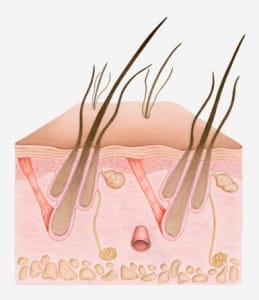 In an effort to find a cure for baldness, research teams from around the world are investigating ways to reawaken dormant hair follicles. These tiny bulb-shaped structures are located just beneath the surface of the skin (pictured left), and they supply growing hair with blood, oxygen, and other life-sustaining nutrients. When hair follicles become traumatized, damaged, or otherwise inactive, the growth of new hair stops and pattern baldness begins. In this way, an individual’s head of hair (quite literally) lives and dies by the health of the follicles beneath the skin. New research suggests that vitamin D, along with the receptors in the skin that bind to the nutrient, may play a significant role in promoting healthy follicles and hair growth.
In an effort to find a cure for baldness, research teams from around the world are investigating ways to reawaken dormant hair follicles. These tiny bulb-shaped structures are located just beneath the surface of the skin (pictured left), and they supply growing hair with blood, oxygen, and other life-sustaining nutrients. When hair follicles become traumatized, damaged, or otherwise inactive, the growth of new hair stops and pattern baldness begins. In this way, an individual’s head of hair (quite literally) lives and dies by the health of the follicles beneath the skin. New research suggests that vitamin D, along with the receptors in the skin that bind to the nutrient, may play a significant role in promoting healthy follicles and hair growth.
Got Milk? Researchers Say Vitamin D is “Crucial for the regeneration of hair”
Thanks in part to wildly successful 1995 “Got Milk?” advertising campaign by Goodby Silverstein & Partners, we all know that the calcium and vitamin D in milk help develop strong bones and prevent osteoporosis. The health benefits of vitamin D were studied long before that campaign, but traditional research focused primarily on vitamin D and bone development.
Now, however, new research shows vitamin D may be “crucial for the regeneration of hair,” (i). Hair transplant surgeons have also credited the receptors for vitamin D—the tiny “keyholes” in which the vitamin “keys” fit when being utilized by the body—as critical in promoting healthy hair follicle function.
Researchers report that creating a vitamin D supplement to prevent hair loss is tricky, however. For one, too much vitamin D may cause calcium accumulation in the blood. In turn, calcium accumulation may cause weakness or problems with the kidneys. For this reason, researchers are “really aiming to manipulate vitamin D or vitamin D receptors only in the skin,” explains Dr. Oda of the VA Medical Center in San Francisco. This would help individuals better utilize the vitamin D in their system, rather than introduce more vitamin D at the risk of developing other health issues.
And while a vitamin D supplement that cures baldness may seem futuristic and fanciful, there are technologies available today that are designed to promote natural hair growth by stimulating hair follicles.
Enter: Low level laser therapy (LLLT) for hair.
Promoting Follicle Health and Hair Growth with LLLT
LLLT stands for low level laser treatment, and it is a relatively new and exciting technology for the medical world. LLLT uses safe, FDA certified lasers to stimulate cellular respiration by way of phototherapy. In turn, this increases the cell’s ability to produce energy. But how do laser-light exposure, enhanced cellular respiration, and increased energy production help to reverse hair loss?
According to new research, an improvement in cellular respiration leads a series of biochemical reactions that stimulate the delivery of oxygen and nutrients directly to the hair follicle (vi). Most important is the ability of the patient to receive comprehensive LLLT exposure on a regular basis—usually 3 times per week for about 20 minutes per session.
Learn More About the LaserCap™
To learn more about hair restoration or low level laser hair therapy with the LaserCap™, please schedule an appointment with the Hair Transplant Institute of Miami. Readers are also invited to call our front desk at 305.925.0222 to speak directly with a friendly member of our office.
At the Hair Transplant Institute of Miami, we understand that hair loss can impact your personal, social, and professional life. We’re committed to making a difference in the lives and well-being of our patients, and we look forward to exceeding your expectations with only the best technologies and most effective procedures.
Sources for this article include:
(i) Wang, Shirley S. “The Search for a Baldness Cure.” 12 September 2012.
(ii) Brosseau, L.; Welch, V.; Wells, G. A.; De Bie, R.; Gam, A.; Harman, K.; Morin, M.; Shea, B. et al. (2005). Brosseau, Lucie. ed. “Low level laser therapy (Classes I, II and III) for treating rheumatoid arthritis”. Cochrane Database of Systematic Reviews (4): CD002049. doi:10.1002/14651858.CD002049.pub2. PMID 16235295.
(iii) Jamtvedt, G.; Dahm, K. T.; Christie, A.; Moe, R. H.; Haavardsholm, E.; Holm, I.; Hagen, K. B. (2007). “Physical Therapy Interventions for Patients with Osteoarthritis of the Knee: an Overview of Systematic Reviews”. Physical Therapy 88 (1): 123–136. doi:10.2522/ptj.20070043. PMID 17986496.
(iv) Chow, R.; Johnson, M.; Lopes-Martins, R.; Bjordal, J. (Nov 2009). “Efficacy of low-level laser therapy in the management of neck pain: a systematic review and meta-analysis of randomised placebo or active-treatment controlled trials.”. Lancet 374 (9705): 1897–1908. doi:10.1016/S0140-6736(09)61522-1. PMID 19913903.
(v) Hamblin, Michael R. “Mechanisms of Low Level Light Therapy.” (2008): n. pag. Web. 17 Sept. 2012.
(vi) Hamblin, Michael R. “Low Level Laser Light Therapy.” (2012). n. pag. Web. 17 Sep. 2012. Click Here to Read This Article.

